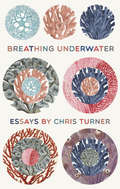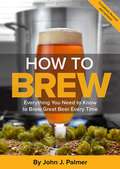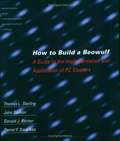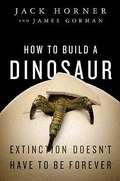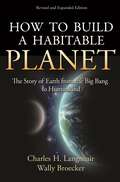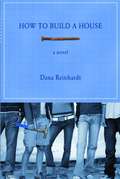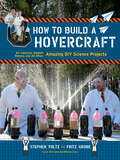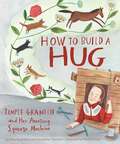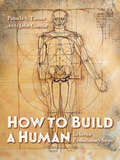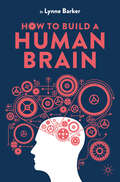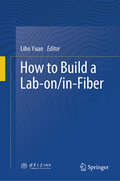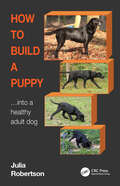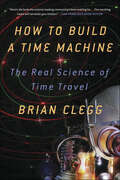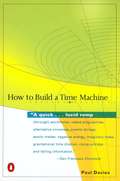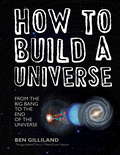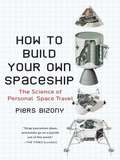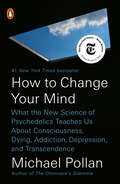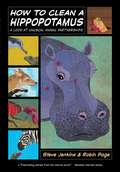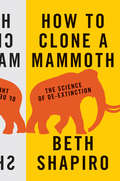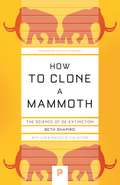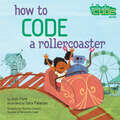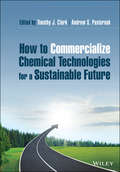- Table View
- List View
How to Breathe Underwater
by Chris TurnerThe essays and reportage in How to Breathe Underwater offer a panoramic overview of this age of radical change-from the online gambling boom in the Caribbean to Cyberjaya, the Malaysian government's attempt to build its own Silicon Valley; from video game design to digital-age tabloid journalism to the artistry of The Simpsons; and from the fate of the Great Barrier Reef to Cuba's economic limbo after the fall of the Soviet empire. In field reports that survey the rise of the internet in the 1990s, analyze the changing nature of mass culture in the digital age, and provide a multifaceted look at how human industry is shaping the planet's foundations, this collection presents a fractal portrait of a society in rapid flux. Chris Turner is the author of four previous books, a nine-time National Magazine Award winner and a sought-after speaker on the rise of the global green economy, as well as a celebrated feature writer for The Walrus, Canadian Geographic, The Globe & Mail and other major publications. His lively and passionate reportage, along with his incisive essays and shrewd cultural criticism, have for the past fifteen years made essential contributions to the debates on our climate, culture, and technology. They are collected here for the first time.Praise for How To Breathe Underwater"Chris Turner is among the best magazine writers on the planet. His writing is so beautiful, wry and well-reported that it's spellbinding. And spellbreaking: He wakes you up, makes you sit upright and look afresh at our culture, our climate, and where we need to go. This is literary nonfiction at its finest."-Clive Thompson, Wired columnist and author of Smarter Than You Think"Chris Turner is the master of long-form journalism in Canada, a smart, funny, and endlessly curious envoy to everywhere. This collection gathers his best work, forging links of meaning in a chain of superb reporting and writing; readers will see many choice pieces and realize, maybe for the first time, that they were all fashioned by the same indefatigable intelligence."-Mark Kingwell, the author of A Civil Tongue"Whatever you choose to call this kind of stylishly reported, deeply engaged, richly nuanced, gorgeously written nonfiction--saturation reportage, new journalism, longform writing--it without question qualifies as real literature. It's the only kind of journalism that gets remembered, and the only kind that produces real change. Chris Turner has been writing it since he started taking notes."-Ian Brown, author of The Boy in the Moon and Globe & Mail feature writer
How To Brew: Everything You Need to Know to Brew Great Beer Every Time
by John J. PalmerHow to Brew is the definitive guide to making quality beers at home. Whether you want simple, sure-fire instructions for making your first beer, or you&’re a seasoned homebrewer working with all-grain batches, this book has something for you. John Palmer adeptly covers the full range of brewing possibilities—accurately, clearly and simply. From ingredients and methods to recipes and equipment for brewing beer at home, How to Brew is loaded with valuable information on brewing techniques and recipe formulation.A perennial best seller since the release of the third edition in 2006, How to Brew, is a must-have to update every new and seasoned brewer&’s library.This completely revised and updated edition includes:More emphasis on the &“top six priorities&”: sanitation, fermentation temperature control, yeast management, the boil, good recipes, and water.Five new chapters covering malting and brewing, strong beers, fruit beers, sour beers, and adjusting water for style.All other chapters revised and expanded:Expanded and updated charts, graphs, equations, and visuals.Expanded information on using beer kits.Thorough revision of mashing and lautering chapters:Expanded tables of recommended times and temperatures for single-infusion, multiple-step, and decoction mashing.Complete discussion of first wort gravity as a function of water to grist ratio.Complete revision of infusion and decoction equations.Revised and updated information on managing your fermentation:Yeast pitching and starters. Yeast starter growth factors.Yeast and the maturation cycle.And much more!
How to Build a Beowulf: A Guide to the Implementation and Application of PC Clusters
by Thomas L. Sterling John Salmon Donald J. Becker Daniel F. SavareseSupercomputing research--the goal of which is to make computers that are ever faster and more powerful--has been at the cutting edge of computer technology since the early 1960s. Until recently, research cost in the millions of dollars, and many of the companies that originally made supercomputers are now out of business. The early supercomputers used distributed computing and parallel processing to link processors together in a single machine, often called a mainframe. Exploiting the same technology, researchers are now using off-the-shelf PCs to produce computers with supercomputer performance. It is now possible to make a supercomputer for less than $40,000. Given this new affordability, a number of universities and research laboratories are experimenting with installing such Beowulf-type systems in their facilities. This how-to guide provides step-by-step instructions for building a Beowulf-type computer, including the physical elements that make up a clustered PC computing system, the software required (most of which is freely available), and insights on how to organize the code to exploit parallelism. The book also includes a list of potential pitfalls.
How to Build a Dinosaur
by Jack Horner James GormanA world-renowned paleontologist reveals groundbreaking science that trumps science fiction: how to grow a living dinosaur Over a decade after Jurassic Park, Jack Horner and his colleagues in molecular biology labs are in the process of building the technology to create a real dinosaur. Based on new research in evolutionary developmental biology on how a few select cells grow to create arms, legs, eyes, and brains that function together, Jack Horner takes the science a step further in a plan to "reverse evolution" and reveals the awesome, even frightening, power being acquired to recreate the prehistoric past. The key is the dinosaur's genetic code that lives on in modern birds- even chickens. From cutting-edge biology labs to field digs underneath the Montana sun, How to Build a Dinosaur explains and enlightens an awesome new science.
How to Build a Habitable Planet: The Story of Earth from the Big Bang to Humankind - Revised and Expanded Edition
by Charles H. Langmuir Wallace BroeckerA classic introduction to the story of Earth's origin and evolution—revised and expanded for the twenty-first centurySince its first publication more than twenty-five years ago, How to Build a Habitable Planet has established a legendary reputation as an accessible yet scientifically impeccable introduction to the origin and evolution of Earth, from the Big Bang through the rise of human civilization. This classic account of how our habitable planet was assembled from the stuff of stars introduced readers to planetary, Earth, and climate science by way of a fascinating narrative. Now this great book has been made even better. Harvard geochemist Charles Langmuir has worked closely with the original author, Wally Broecker, one of the world's leading Earth scientists, to revise and expand the book for a new generation of readers for whom active planetary stewardship is becoming imperative.Interweaving physics, astronomy, chemistry, geology, and biology, this sweeping account tells Earth’s complete story, from the synthesis of chemical elements in stars, to the formation of the Solar System, to the evolution of a habitable climate on Earth, to the origin of life and humankind. The book also addresses the search for other habitable worlds in the Milky Way and contemplates whether Earth will remain habitable as our influence on global climate grows. It concludes by considering the ways in which humankind can sustain Earth’s habitability and perhaps even participate in further planetary evolution.Like no other book, How to Build a Habitable Planet provides an understanding of Earth in its broadest context, as well as a greater appreciation of its possibly rare ability to sustain life over geologic time.Leading schools that have ordered, recommended for reading, or adopted this book for course use:Arizona State UniversityBrooklyn College CUNYColumbia UniversityCornell UniversityETH ZurichGeorgia Institute of TechnologyHarvard UniversityJohns Hopkins UniversityLuther CollegeNorthwestern UniversityOhio State UniversityOxford Brookes UniversityPan American UniversityRutgers UniversityState University of New York at BinghamtonTexas A&M UniversityTrinity College DublinUniversity of BristolUniversity of California-Los AngelesUniversity of CambridgeUniversity Of ChicagoUniversity of Colorado at BoulderUniversity of GlasgowUniversity of LeicesterUniversity of Maine, FarmingtonUniversity of MichiganUniversity of North Carolina at Chapel HillUniversity of North GeorgiaUniversity of NottinghamUniversity of OregonUniversity of OxfordUniversity of PortsmouthUniversity of SouthamptonUniversity of UlsterUniversity of VictoriaUniversity of WyomingWestern Kentucky UniversityYale University
How to Build a House
by Dana ReinhardtHarper's dad is getting a divorce from her beloved stepmother, Jane. Even worse, Harper has lost her stepsister, Tess; the divorce divides them. Harper decides to escape by joining a volunteer program to build a house for a family in Tennessee who lost their home in a tornado. Not that she knows a thing about construction. Soon she's living in a funky motel and working long days in blazing heat with a group of kids from all over the country. At the site, she works alongside Teddy, the son of the family for whom they are building the house. Their partnership turns into a summer romance, complete with power tools. Learning to trust and love Teddy isn't easy for Harper, but it's the first step toward finding her way back home.
How to Build a Hovercraft: Air Cannons, Magnetic Motos, and 25 Other Amazing DIY Science Projects
by Stephen Voltz Fritz GrobeWith this fun yet informative guide for all skill levels, create extraordinary science experiments you can do at home using everyday objects. From the Coke and Mentos fountain makers who found initial fame via Maker Faire and YouTube (more than 150 million views!) comes this collection of DIY science projects guaranteed to inspire a love of experimentation. Fritz Grobe and Stephen Voltz, also known as EepyBird, share their favorite projects: a giant air vortex cannon, a leaf blower hovercraft, a paper airplane that will fly forever, and many more. Each experiment features instructions that will take users from amateur to showman level—there&’s something here for all skill levels—alongside illustrations, photographs, and carefully explained science. How to Build a Hovercraft is guaranteed to engage curious minds and create brag-worthy results! Caution: Many of these experiments require adult supervision, and some of them should not be performed by children at all. Praise for How to Build a Hovercraft &“Want to create big, splashy projects mostly using household items? This fun book contains detailed step-by-step instructions, well-thought-out scientific explanations, and sensible safety precautions.&” —Natural History, Holiday Gift Guide Pick
How to Build a Hug: Temple Grandin And Her Amazing Squeeze Machine
by Amy GuglielmoAmy Guglielmo, Jacqueline Tourville, and Giselle Potter come together to tell the inspiring story of autism advocate Dr. Temple Grandin and her brilliant invention: the hug machine. <P><P> As a young girl, Temple Grandin loved folding paper kites, making obstacle courses, and building lean-tos. But she really didn’t like hugs. Temple wanted to be held—but to her, hugs felt like being stuffed inside the scratchiest sock in the world; like a tidal wave of dentist drills, sandpaper, and awful cologne, coming at her all at once. Would she ever get to enjoy the comfort of a hug? <P><P> Then one day, Temple had an idea. If she couldn’t receive a hug, she would make one…she would build a hug machine!
How to Build a Human: In Seven Evolutionary Steps
by Pamela S. TurnerThe epic story of our evolution in seven big steps!How did we become who we are? With trademark wit, acclaimed science writer Pamela S. Turner breaks down human evolution into the seven most important steps leading to Homo sapiens. How, when, and why did we:1. stand up,2. smash rocks,3. get swelled heads,4. take a hike,5. invent barbecue,6. start talking (and never shut up), and 7. become storytellers?This fascinating, wickedly funny account of our evolutionary journey turns science into an irresistible story. Vetted by experts at the Smithsonian's Human Origins Program, the book also features incredibly detailed portraits by celebrated paleo-artist John Gurche that bring our early ancestors to life.
How to Build a Human Brain
by Lynne BarkerHow to Build a Human Brain takes a developmental approach to understanding brain structure and function. It guides readers through the evolution of the human brain, from its cellular building blocks, up to hind brain structures and functions, and through to neocortex and associated functions. In doing so, it enables students to develop a comprehensive knowledge of the relationship between brain networks and functions, neural underpinnings of functional problems seen after neuropathology, and neuroanatomy.Written in an engaging style, each chapter follows a blueprint format with subsections on issues like 'damage and repair' and 'faulty wiring' as the brain is ‘built’ across the course of the book. The author includes illustrative case studies and entertaining fast fact boxes to highlight the real-word relevance of each brain structure being examined. This textbook offers an accessible reference for students of neuroscience, cognitive neuroscience, neuropsychology,and biological psychology.
How to Build a Lab-on/in-Fiber
by Libo YuanThis book explores the technical foundations of constructing diverse laboratories on optical fiber. In recent years, microstructured-based optical fiber devices and sensors have emerged as a rapidly advancing area within the field of optical fiber sensing technology. The concept of creating a laboratory on optical fiber has been inspired by advances in micro-structured fiber optics. Given the natural existence of optical waveguide channels within fibers, it is feasible to integrate a wide range of materials such as inorganic, organic, biological, and nonlinear optical substances—into or onto the fiber's end face or side. This integration facilitates the interaction between light and matter, leading to measurable optical outcomes through the fiber's optical channel. The rapid evolution of this concept is driven by the ease with which strong interactions can be achieved between light and matter at the micro-nano scale within the fiber, making it an ideal platform for experiments in lightwave microscale physics, photochemistry, and the interaction between light and both biological and microbial materials. The fiber optics laboratory thus offers a compelling stage for interdisciplinary research endeavors. This book serves as a comprehensive and systematic introduction to the core techniques involved in establishing various laboratories on fiber, complemented by practical examples that illustrate the purpose, methodology, and technical approaches to developing fiber-based laboratories. It stands as an invaluable reference for students and researchers intrigued by the cutting-edge advancements in fiber optic technology.
How to Build a Puppy: Into a Healthy Adult Dog
by Julia RobertsonDogs do not demonstrate discomfort or pain in a way that can be easily translated by us humans, so we often miss that they are physically struggling. Understanding that making some very simple changes to our homes, activities, exercise regimes and how we train our puppies will have a massive positive impact on our dogs' lives. Using her world-renowned Galen Myotherapy knowledge and approach, Robertson suggests and explains in detail how small, profoundly important but easy to implement changes can improve the way we not only look after and develop our puppies but also how maintenance of this easy programme continues your puppy’s journey through into healthy adolescence and maturity. Environment, exercise and activity habits have deep, ongoing effects and How to Build a Puppy ... into a healthy adult dog explores ways in which positive change can be integrated easily into our normal lives. The book culminates into a full programme called the Galen Myotherapy Puppy Physical Development Programme©. Including: A dedicated section on anatomy, explaining in a functional way how everything in the body interrelates to form a functional moving structure Practical advice that is made logical and easy to interpret by the use of clear comparative descriptions as well as clear diagrams and pictures showing the movement and biomechanics of dogs Exercises and activities in a practical programme, for all situations, that can be followed to help build good foundations A full pictorial explanation of why so many 'traditional' exercise routines and activities are in fact incredibly damaging for our dogs This book will help canine professionals better advise their clients, but also empower all readers to make their own changes, as well as having a better all-round understanding to enable more pertinent questions from their vet, breeder or puppy trainer.
How to Build a Time Machine: The Real Science of Time Travel
by Brian CleggThis look at time travel technology gives “a solid overview of some of the quirkier corners of physics, with an entertaining connection to pop culture” (Kirkus Reviews).In How to Build a Time Machine, physicist Brian Clegg provides an understanding of what time is and how it can be manipulated. He explores the fascinating speculations and the remarkable possibilities of real time travel that emerge from quantum entanglement, superluminal speeds, neutron star cylinders and wormholes in space. With the paradoxes of time travel echoing in our minds, will we realize that travel into the future might never be possible? Or will we realize there is no limit on what can be achieved, and take on this ultimate challenge? Only time will tell.“Dissects schemes such as going into the past and playing the stock market armed with foreknowledge of what will rise or fall. He covers most of the themes advanced by science fiction, plus some of the more adventurous scientific minds, generally avoiding math or tricky technical details.” —Kirkus Reviews“Explain[s] quantum entanglement and superluminal speeds in terms that even a technophobe could understand.” —Publishers Weekly“A genuinely intriguing book.” —Booklist“Clegg excels at making science accessible.” —Library Journal
How to Build a Time Machine
by Paul DaviesWith his unique knack for making cutting-edge theoretical science effortlessly accessible, world-renowned physicist Paul Davies now tackles an issue that has boggled minds for centuries: Is time travel possible? The answer, insists Davies, is definitely yes—once you iron out a few kinks in the space-time continuum. With tongue placed firmly in cheek, Davies explains the theoretical physics that make visiting the future and revisiting the past possible, then proceeds to lay out a four-stage process for assembling a time machine and making it work. Wildly inventive and theoretically sound, How to Build a Time Machine is creative science at its best—illuminating, entertaining, and thought provoking. .
How to Build a Universe: From the Big Bang to the End of the Universe
by Ben GillilandFrom the first particles of matter and atomic building-blocks to hydrogen fusion, large galaxies and supermassive black holes, with a healthy dose of history and fun facts to glue everything together, this is your very own guide to How to Build a Universe. Using a mixture of eye-catching graphics, humour and structured narrative, in How to Build a Universe, Metro columnist Ben Gilliland explains the complex concepts surrounding the birth and development of the galaxies, without overwhelming or patronising the reader. Gilliland demonstrates how the cosmos came to be - from the formation of the first particles in the Big Bang to the development of the first stars, galaxies, planets and leading up to the present day and where the future of the universe might lie. Each chapter has an ongoing narrative, building the universe piece by piece, with graphics and fact boxes interspersed throughout.
How to Build Your Own Spaceship
by Piers BizonyLadies and gentlemen, start your spaceships! Personal space travel is no longer the stuff of science fiction. The future is here: Civilians are launching into orbit. As early as 2010 paying customers will have the opportunity to experience weightlessness, courtesy of Virgin Galactic's inaugural launch. How to Build Your Own Spaceship takes readers on a fun and quirky trip to the forefront of commercial space travel-the latest technology, the major business players, and the personal and financial benefits that are ripe for the picking. Science-writer Piers Bizony's breadth of knowledge, quick wit, and no-nonsense explanations of the hard science in this emerging arena will satisfy even the most dedicated space fanatics. With practical advice (from picking the best jet fuel to funding your own fleet of space crafts), unbelievable space facts, and fascinating photos, Bizony's user-friendly guide to blasting off is a must-have ticket to the final frontier. .
How to Change Your Mind: What the New Science of Psychedelics Teaches Us About Consciousness, Dying, Addiction, Depression, and Transcendence
by Michael PollanNew York Times Book Review 10 Best Books of 2018A New York Times Notable Book The #1 New York Times bestseller.A brilliant and brave investigation into the medical and scientific revolution taking place around psychedelic drugs--and the spellbinding story of his own life-changing psychedelic experiences When Michael Pollan set out to research how LSD and psilocybin (the active ingredient in magic mushrooms) are being used to provide relief to people suffering from difficult-to-treat conditions such as depression, addiction and anxiety, he did not intend to write what is undoubtedly his most personal book. But upon discovering how these remarkable substances are improving the lives not only of the mentally ill but also of healthy people coming to grips with the challenges of everyday life, he decided to explore the landscape of the mind in the first person as well as the third. Thus began a singular adventure into various altered states of consciousness, along with a dive deep into both the latest brain science and the thriving underground community of psychedelic therapists. Pollan sifts the historical record to separate the truth about these mysterious drugs from the myths that have surrounded them since the 1960s, when a handful of psychedelic evangelists inadvertently catalyzed a powerful backlash against what was then a promising field of research.A unique and elegant blend of science, memoir, travel writing, history, and medicine, How to Change Your Mind is a triumph of participatory journalism. By turns dazzling and edifying, it is the gripping account of a journey to an exciting and unexpected new frontier in our understanding of the mind, the self, and our place in the world. The true subject of Pollan's "mental travelogue" is not just psychedelic drugs but also the eternal puzzle of human consciousness and how, in a world that offers us both suffering and joy, we can do our best to be fully present and find meaning in our lives.
How to Clean a Hippopotamus: A Look at Unusual Animal Partnerships
by Robin Page Steve JenkinsHow to Clean a Hippopotamus, a book about animal symbiosis, offers readers a close-up, step-by-step view of nature’s fascinating partnerships. Find out why a mongoose comes running when a warthog lies down, how a crab and an iguana help each other out, why ravens follow wolves, and more.
How to Clone a Mammoth
by Beth ShapiroCould extinct species, like mammoths and passenger pigeons, be brought back to life? The science says yes. In How to Clone a Mammoth, Beth Shapiro, evolutionary biologist and pioneer in "ancient DNA" research, walks readers through the astonishing and controversial process of de-extinction. From deciding which species should be restored, to sequencing their genomes, to anticipating how revived populations might be overseen in the wild, Shapiro vividly explores the extraordinary cutting-edge science that is being used--today--to resurrect the past. Journeying to far-flung Siberian locales in search of ice age bones and delving into her own research--as well as those of fellow experts such as Svante Pääbo, George Church, and Craig Venter--Shapiro considers de-extinction's practical benefits and ethical challenges. Would de-extinction change the way we live? Is this really cloning? What are the costs and risks? And what is the ultimate goal? Using DNA collected from remains as a genetic blueprint, scientists aim to engineer extinct traits--traits that evolved by natural selection over thousands of years--into living organisms. But rather than viewing de-extinction as a way to restore one particular species, Shapiro argues that the overarching goal should be the revitalization and stabilization of contemporary ecosystems. For example, elephants with genes modified to express mammoth traits could expand into the Arctic, re-establishing lost productivity to the tundra ecosystem. Looking at the very real and compelling science behind an idea once seen as science fiction, How to Clone a Mammoth demonstrates how de-extinction will redefine conservation's future.
How to Clone a Mammoth: The Science of De-Extinction (Princeton Science Library #108)
by Beth ShapiroAn insider's view on bringing extinct species back to lifeCould extinct species, like mammoths and passenger pigeons, be brought back to life? In How to Clone a Mammoth, Beth Shapiro, an evolutionary biologist and pioneer in ancient DNA research, addresses this intriguing question by walking readers through the astonishing and controversial process of de-extinction. From deciding which species should be restored to anticipating how revived populations might be overseen in the wild, Shapiro vividly explores the extraordinary cutting-edge science that is being used to resurrect the past. Considering de-extinction's practical benefits and ethical challenges, Shapiro argues that the overarching goal should be the revitalization and stabilization of contemporary ecosystems. Looking at the very real and compelling science behind an idea once seen as science fiction, How to Clone a Mammoth demonstrates how de-extinction will redefine conservation's future.
How to Code a Rollercoaster
by Josh FunkPearl and Pascal take their coding adventures to the amusement park in this follow-up picture book from our Girls Who Code program!Pearl and her trusty rust-proof robot, Pascal, are enjoying a day out at the amusement park. Spinning teacups, ice cream, and of course: rollercoasters! Through the use of code, Pearl and Pascal can keep track of their ride tokens and calculate when the line is short enough to get a spot on the biggest ride of them all--the Python Coaster. Variables, if-then-else sequences, and a hunt for a secret hidden code make this a humorous, code-tastic day at the amusement park!
How to Commercialize Chemical Technologies for a Sustainable Future
by Timothy J. ClarkThe definitive guide for scientific entrepreneurs commercializing sustainable technologies in the chemical sector Lacking the considerable resources of multinational chemical companies, entrepreneurs face a unique set of risks and challenges. How to Commercialize Chemical Technologies for a Sustainable Future is targeted at innovators who are embarking on the entrepreneurial path with their sustainable chemical technology but are unsure of what steps to take. This first-of-its-kind resource features contributions from a diverse team of expert authors, including engineers, venture capitalists, marketing specialists, intellectual property professionals, regulatory experts, industry practitioners, and many others. Accessible and highly practical, this real-world guide covers each step of the technology commercialization process, from market landscape analysis and financing to scale-up and strategic partnering. Throughout the book, effective tactics and strategies for growing a new venture are supported by case studies highlighting the economic and environmental impact of successful commercialization, and identifying the common mistakes that lead to lost opportunities. Filled with invaluable advice and actionable steps, this book: Uses valuation concepts, tools, and examples to demonstrate that for a chemical technology to be sustainable it must not only have market value but also confer benefits to human well-being and the environment Offers templates and tools for understanding what customers need, who the competition is and how to successfully differentiate your product to those customers Describes how to practically advance your technology from conception all the way to commercial demonstration Presents advantages and disadvantages of strategic partnering from the perspective of the start-up and the larger industrial partner, along with strategies to mitigate risks within a partnership Provides an overview of the legal regulatory requirements for bringing new chemicals to market in several key geographic regions, as well as the impact of public policy on commercialization Offers insights and practical strategies on intellectual property management, raising investment, and operationalizing a startup company How to Commercialize Chemical Technologies for a Sustainable Future is essential reading for budding entrepreneurs in chemistry, materials science, and chemical engineering looking to bring their sustainable technologies to market. It is also a valuable reference for investors, policymakers, regulators, and other professionals.
How to Cool the Planet: Geoengineering and the Audacious Quest to Fix Earth's Climate
by Jeff GoodellWhen Jeff Goodell first encountered the term "geoengineering," he had a vague sense that it involved outlandish schemes to counteract global warming. As a journalist, he was deeply skeptical. But he was also intrigued. The planet was in trouble. Could geoengineers help? Climate change may well be the biggest crisis humanity has ever faced. Temperatures in some regions of the world could increase by as much as fifteen degrees by the end of the century, causing rising sea levels and severe droughts. But change could also happen much more suddenly. What if we had a real climate emergency, the ecological equivalent of the subprime mortgage meltdown -- how could we cool the planet in a hurry? As Goodell shows in this bracing book, even if we could muster the political will for it, cutting greenhouse gas emissions alone may not be enough to reduce the risk of climate catastrophe. This has led some scientists to pursue extreme solutions: huge contraptions that would suck CO2 from the air, machines that would brighten clouds and deflect sunlight away from the earth, even artificial volcanoes that would spray heat-reflecting particles into the atmosphere. In How to Cool the Planet, Goodell explores the scientific, political, financial, and moral aspects of geoengineering. How are we to change the temperature of whole regions if we can't even predict next week's weather? What if a wealthy entrepreneur shoots particles into the stratosphere on his own? What about wars waged with climate control as the primary weapon? What happens to our relationship with nature when, as Goodell puts it, we all find ourselves living in a giant terrarium? And our options are dwindling. Maybe, Goodell suggests, we need to start taking geoengineering seriously. Maybe it's Plan B for the planet. And if it is, we need to know enough to get it right. Thoroughly reported and convincingly argued, How to Cool the Planet is a compelling tale of scientific hubris and technical daring. But it is also a thoughtful, even-handed look at a deeply complex and controversial issue. It's a book that will surely jump-start the next big debate about the future of life on earth.
How to Create a Mind: The Secret of Human Thought Revealed
by Ray KurzweilThe bold futurist and bestselling author explores the limitless potential of reverse-engineering the human brainRay Kurzweil is arguably today’s most influential—and often controversial—futurist. In How to Create a Mind, Kurzweil presents a provocative exploration of the most important project in human-machine civilization—reverse engineering the brain to understand precisely how it works and using that knowledge to create even more intelligent machines.Kurzweil discusses how the brain functions, how the mind emerges from the brain, and the implications of vastly increasing the powers of our intelligence in addressing the world’s problems. He thoughtfully examines emotional and moral intelligence and the origins of consciousness and envisions the radical possibilities of our merging with the intelligent technology we are creating.Certain to be one of the most widely discussed and debated science books of the year, How to Create a Mind is sure to take its place alongside Kurzweil’s previous classics which include Fantastic Voyage: Live Long Enough to Live Forever and The Age of Spiritual Machines.From the Hardcover edition.
How to Create a Mind: The Secret of Human Thought Revealed
by Ray KurzweilThe bestselling author of The Singularity Is Near explores the limitless potential of reverse-engineering the human brain Ray Kurzweil is arguably today's most influential futurist. In How to Create a Mind, he presents a provocative exploration of the most important project in the human-machine civilization: reverse-engineering the brain to understand precisely how it functions and using that knowledge to create even more intelligent machines. Kurzweil discusses how the brain works, how the mind emerges, brain-computer interfaces, and the implications of vastly increasing the powers of our intelligence to address the world's problems. Certain to be one of the most widely discussed and debated science books of the year, How to Create a Mind is sure to take its place alongside Kurzweil's previous classics.
